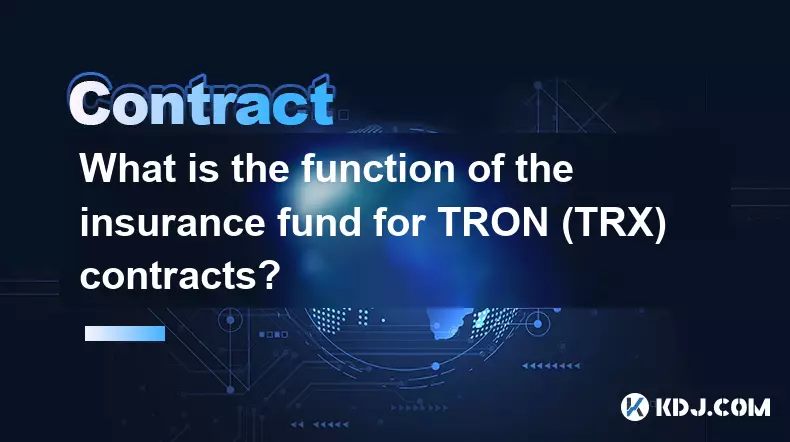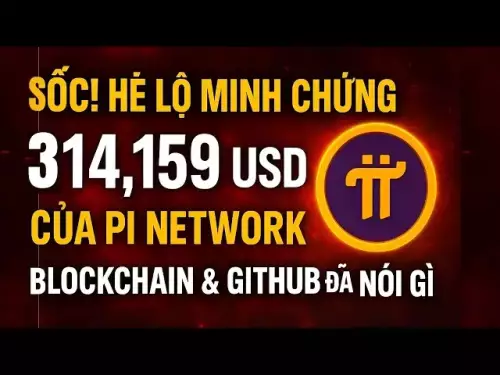-
 bitcoin
bitcoin $109547.008142 USD
0.04% -
 ethereum
ethereum $4011.838726 USD
-0.05% -
 tether
tether $1.000402 USD
-0.01% -
 xrp
xrp $2.798606 USD
0.88% -
 bnb
bnb $970.877944 USD
1.39% -
 solana
solana $202.237275 USD
-0.95% -
 usd-coin
usd-coin $0.999673 USD
0.00% -
 dogecoin
dogecoin $0.229294 USD
-1.15% -
 tron
tron $0.336370 USD
-0.45% -
 cardano
cardano $0.777260 USD
-1.66% -
 hyperliquid
hyperliquid $45.503019 USD
1.73% -
 ethena-usde
ethena-usde $1.000362 USD
0.01% -
 chainlink
chainlink $20.785303 USD
-1.10% -
 avalanche
avalanche $28.755822 USD
-0.11% -
 stellar
stellar $0.358303 USD
-0.48%
What is the function of the insurance fund for TRON (TRX) contracts?
Insurance funds on TRON protect traders by covering liquidation shortfalls, ensuring payouts during volatility and maintaining market stability through transparent, on-chain mechanisms.
Sep 27, 2025 at 09:00 pm

Understanding the Role of Insurance Funds in TRON Contracts
1. The insurance fund within the TRON (TRX) network primarily serves to protect users during volatile market conditions, especially in decentralized finance (DeFi) applications involving perpetual contracts. When liquidations occur due to extreme price movements, the system may not recover enough value from the collateral to cover the remaining debt. In such cases, the insurance fund steps in to absorb the shortfall, ensuring that profitable traders receive their full payouts.
2. These funds are accumulated over time through a portion of the fees collected from each trade executed on TRON-based decentralized exchanges. This mechanism ensures that there is always a financial buffer available when unexpected gaps or flash crashes disrupt normal trading operations. The size of the fund grows with platform usage, reinforcing stability as trading volume increases.
3. Unlike centralized risk management systems, the TRON insurance fund operates transparently on-chain. Anyone can verify its balance and transaction history through blockchain explorers. This transparency builds trust among users who rely on the integrity of smart contract executions without intermediaries overseeing the process.
4. One critical aspect is how the fund prevents socialized losses. Without an insurance pool, unrealized losses from undercollateralized positions could be distributed across all traders, harming innocent participants. By isolating this risk into a dedicated reserve, TRON maintains fairness and encourages broader participation in its ecosystem.
5. The fund also plays a role in mitigating cascading liquidations. During periods of high volatility, multiple positions might become eligible for liquidation simultaneously. If these events overwhelm the available liquidity, the insurance fund acts as a backstop, maintaining orderly settlement and preventing systemic failures within the contract infrastructure.
How Insurance Funds Are Managed on TRON
1. Management of the insurance fund is governed by predefined rules encoded in smart contracts. No single entity has discretionary control over withdrawals or reallocations, which reduces the risk of mismanagement or manipulation. All adjustments follow algorithmic parameters tied to market activity and funding thresholds.
2. Contributions to the fund come directly from trading fees, typically a small percentage deducted from both opening and closing transactions. These micro-deductions scale with volume, allowing the fund to grow organically without imposing additional costs on users.
3. Disbursements occur automatically when a position is liquidated and the collateral left after auction or price feed evaluation falls short of covering the outstanding obligation. The deficit is filled using the reserve, and records of each payout are permanently stored on the blockchain.
4. Regular audits are conducted by third-party firms to ensure alignment between on-chain data and reported fund status. Any discrepancies trigger alerts and initiate corrective protocols, preserving accountability across the network.
5. While the fund cannot prevent individual losses due to leverage misuse, it shields the broader system from spillover effects. This structural safeguard supports long-term confidence in TRON’s financial architecture, particularly for users engaging in high-frequency or leveraged trading strategies.
Impact on Trader Confidence and Market Stability
1. A well-maintained insurance fund enhances trader confidence by reducing counterparty risk. Knowing that payouts are secured even during black swan events makes platforms built on TRON more attractive compared to those lacking similar protections.
2. Stable operations during downturns contribute to consistent pricing and deeper order books. Traders are less likely to withdraw capital abruptly if they perceive the system as resilient, leading to improved liquidity and tighter spreads.
3. Exchanges leveraging TRON’s infrastructure often highlight the existence of the insurance fund in promotional materials. This feature becomes a competitive advantage, especially when attracting institutional or risk-averse investors seeking reliable execution environments.
4. In times of stress, the visibility of a healthy reserve balance can calm panic-driven behavior. Market participants observe that mechanisms are in place to handle crises, which dampens speculative selling and promotes rational decision-making.
5. The presence of an automated safety net allows developers to innovate with new financial instruments without compromising core security. Projects launching derivatives, options, or synthetic assets on TRON benefit from inheriting this foundational layer of protection.
Insurance funds on TRON prevent systemic defaults by covering deficits when liquidated positions fail to repay obligations, ensuring winning traders get paid and maintaining overall market integrity.
Frequently Asked Questions
Can users withdraw from the TRON insurance fund?No, the insurance fund is not accessible to general users. It is a protocol-controlled reserve designed solely to cover losses during liquidations and cannot be claimed or withdrawn by individuals.
Is the insurance fund unique to TRON, or do other blockchains have similar systems?Several blockchain platforms with DeFi derivatives, such as Ethereum-based protocols and Binance Smart Chain projects, employ comparable insurance mechanisms. However, TRON’s implementation emphasizes transparency and automatic allocation through on-chain logic.
What happens if the insurance fund runs out of funds?If the reserve is depleted, the system may temporarily rely on alternative risk mitigation methods, such as increasing collateral requirements or pausing certain high-risk contracts until the fund is replenished through ongoing fee accruals.
Are stablecoins used in the insurance fund?Yes, the fund typically holds assets in stable denominations like USDJ or USDT on the TRON network to maintain predictable purchasing power and facilitate accurate loss compensation regardless of TRX price fluctuations.
Disclaimer:info@kdj.com
The information provided is not trading advice. kdj.com does not assume any responsibility for any investments made based on the information provided in this article. Cryptocurrencies are highly volatile and it is highly recommended that you invest with caution after thorough research!
If you believe that the content used on this website infringes your copyright, please contact us immediately (info@kdj.com) and we will delete it promptly.
- Ethereum, Bitcoin Dominance, and the Altcoin Rally: A New York Minute on Crypto
- 2025-09-28 12:25:15
- RLUSD, XRP, and Open Interest: Decoding the Dynamics
- 2025-09-28 12:25:15
- Crypto Meme Coins: Unveiling the 2025 Potential
- 2025-09-28 12:25:16
- Crypto's Comeback: Solana, Polygon, and the Hunt for the Next Moonshot
- 2025-09-28 12:25:16
- Stablecoins, Financial Transactions, and the Future World: A New York State of Mind
- 2025-09-28 12:30:12
- XRP, Competitor, PDP Climb: Decoding the Crypto Landscape in 2025
- 2025-09-28 12:30:12
Related knowledge

How do I enable the "scalping-only" mode for Cardano (ADA) contracts?
Sep 24,2025 at 03:19am
Understanding Scalping Strategies in Crypto Derivatives1. Scalping in cryptocurrency trading refers to executing multiple short-term trades within min...

What is the settlement time for Cardano (ADA) contracts?
Sep 28,2025 at 04:18am
Understanding Cardano's Contract Settlement Mechanism1. Cardano operates on a proof-of-stake consensus model known as Ouroboros, which fundamentally i...

How do I add margin to Cardano (ADA) contracts?
Sep 27,2025 at 07:54pm
Understanding Margin in Cardano (ADA) Smart ContractsCardano operates on a proof-of-stake blockchain that supports smart contracts through its Plutus ...

What is the maximum position limit for Cardano (ADA) contracts?
Sep 23,2025 at 11:00pm
Understanding ADA Futures and Derivatives Market Structure1. Cardano (ADA) futures contracts are offered by several major cryptocurrency derivatives e...

What is the maker fee for Cardano (ADA) contracts?
Sep 26,2025 at 09:01am
Understanding Maker Fees in Cardano (ADA) Contracts1. The concept of maker fees applies broadly across decentralized exchanges and smart contract plat...

How can I view open interest in Cardano (ADA) contracts?
Sep 24,2025 at 07:36am
Understanding Open Interest in Cardano Derivatives1. Open interest refers to the total number of outstanding derivative contracts, such as futures or ...

How do I enable the "scalping-only" mode for Cardano (ADA) contracts?
Sep 24,2025 at 03:19am
Understanding Scalping Strategies in Crypto Derivatives1. Scalping in cryptocurrency trading refers to executing multiple short-term trades within min...

What is the settlement time for Cardano (ADA) contracts?
Sep 28,2025 at 04:18am
Understanding Cardano's Contract Settlement Mechanism1. Cardano operates on a proof-of-stake consensus model known as Ouroboros, which fundamentally i...

How do I add margin to Cardano (ADA) contracts?
Sep 27,2025 at 07:54pm
Understanding Margin in Cardano (ADA) Smart ContractsCardano operates on a proof-of-stake blockchain that supports smart contracts through its Plutus ...

What is the maximum position limit for Cardano (ADA) contracts?
Sep 23,2025 at 11:00pm
Understanding ADA Futures and Derivatives Market Structure1. Cardano (ADA) futures contracts are offered by several major cryptocurrency derivatives e...

What is the maker fee for Cardano (ADA) contracts?
Sep 26,2025 at 09:01am
Understanding Maker Fees in Cardano (ADA) Contracts1. The concept of maker fees applies broadly across decentralized exchanges and smart contract plat...

How can I view open interest in Cardano (ADA) contracts?
Sep 24,2025 at 07:36am
Understanding Open Interest in Cardano Derivatives1. Open interest refers to the total number of outstanding derivative contracts, such as futures or ...
See all articles










































































